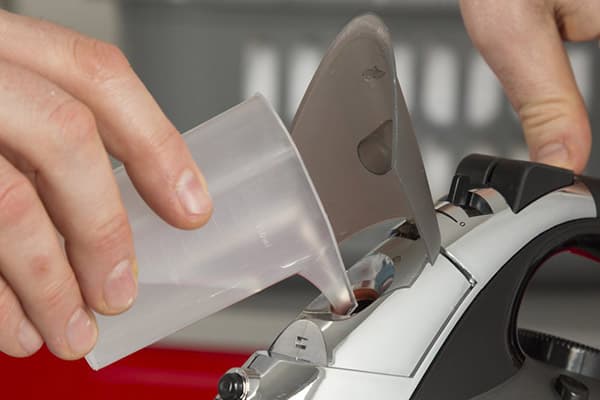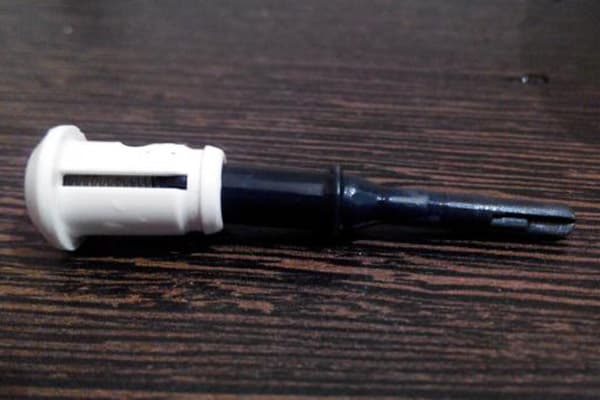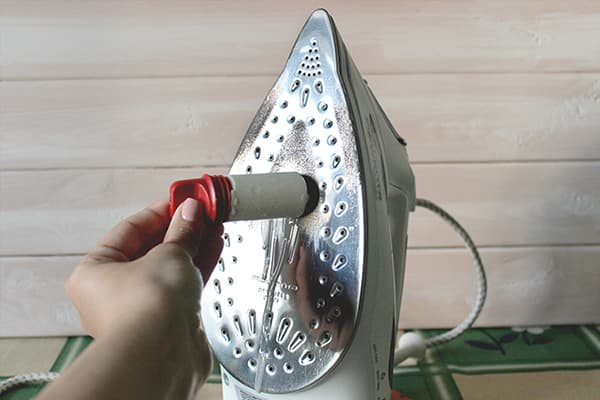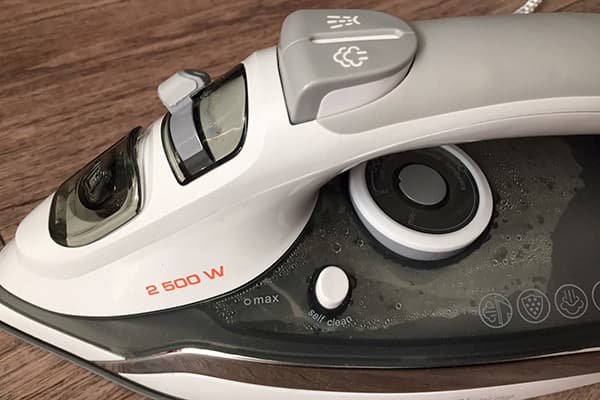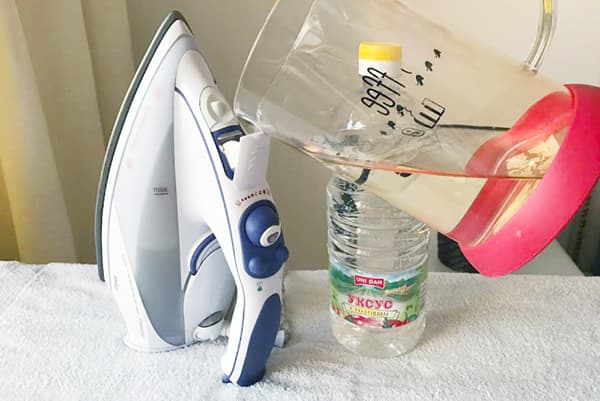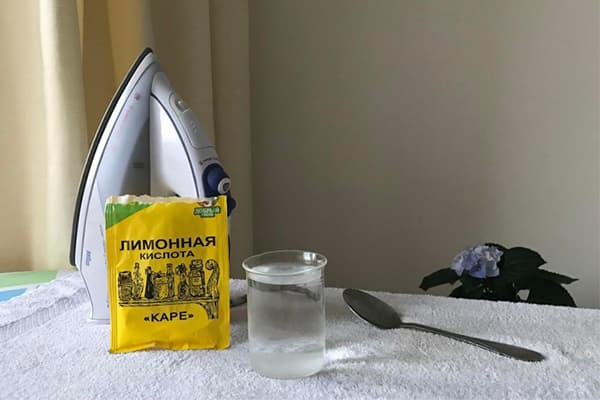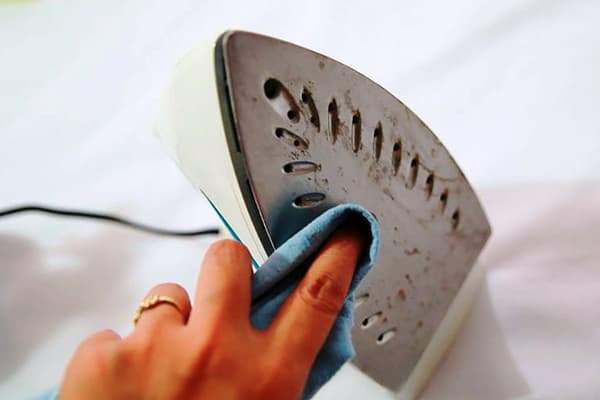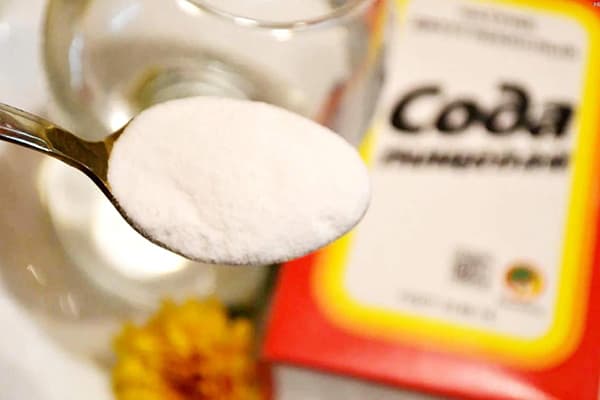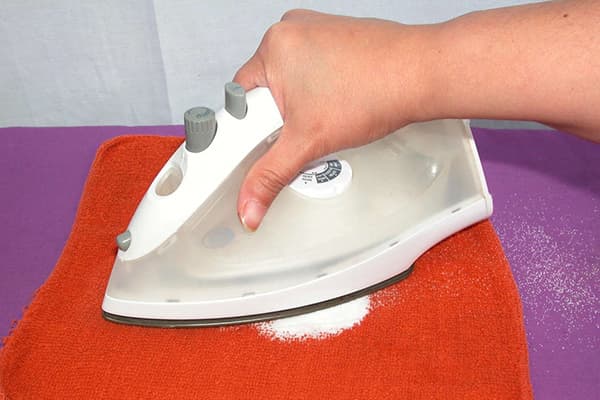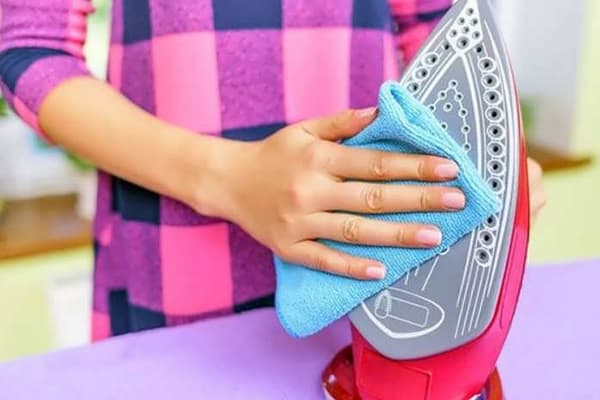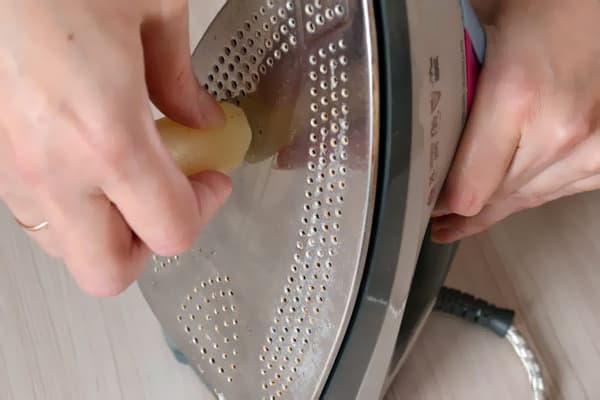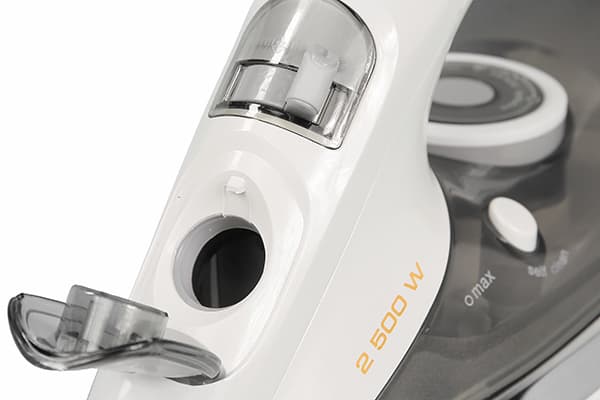How to clean the iron from scale inside and remove plaque from the outside?
Content:
stepwise For steam irons, limescale deposits are a common problem. Therefore, it is useful for every housewife to know how to clean the iron from scale inside and out. Manufacturers give clear recommendations on this matter. Some devices have a self-cleaning function, and special chemicals are also produced. There was also folk wisdom: many people got used to cleaning the iron with improvised means, such as citric acid, salt, vinegar. Let's consider all possible ways to clean the device from plaque.
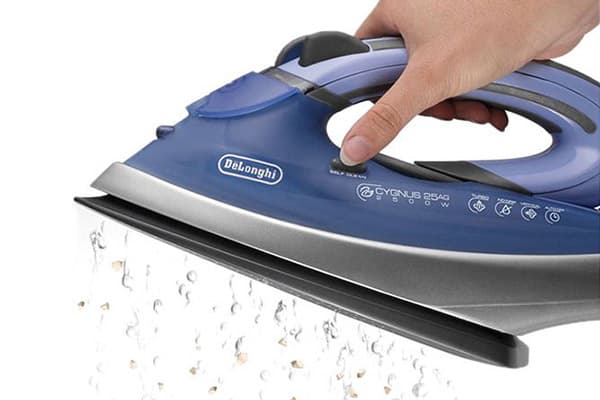
Manufacturers' recommendations
Today irons are mostly steam. This means that they are susceptible to scale formation. When heated, the salts contained in the water turn into hard lime deposits. They settle on the walls inside the device, on the heating element, clog the holes, and contaminate the soleplate. As a result, the iron overheats and may one day break. Also, limescale flies out when steam is applied and stains clothes. In any case, you need to get rid of it, but it is important to do it correctly.
Iron manufacturers have long been puzzled by the fight against scale. To eliminate this, the “Self clean” function was invented and a filter was built in to collect sedimentary salts from the water.
“Self clean” is an automated system for cleaning the insides of modern steam irons. How to use it?
- Fill the iron to the top with distilled water.
- Connect to power.
- Set the heating temperature to maximum.
- Hot water will help the scale fall off.
- After the indicator goes off (the device has warmed up), unplug the iron.
- Bring the iron to the sink or place the iron sole down over a wide basin.
- Press and hold the “Self clean” button until all the water, along with scale and dirt, flows out (it will flow out of the sole).
- Periodically, gently shake the iron so that the scale does not stagnate anywhere and is completely removed.
- The process may be accompanied by occasional release of steam - this is a variant of the norm.
- After completing the procedure, the iron must be heated and the soleplate must be rubbed over unnecessary lint-free cloth to remove any remaining scale that may have lingered on the surface.
The procedure is carried out as needed. A very dirty iron can be cleaned 2 times in a row to be sure.
Also, in critical situations, manufacturers allow the use of special cleaning agents:
- Glutoclean;
- Toperr;
- "Antiscale";
- Sano Antikalk Kettle;
- Astonish;
- chemical pencil, etc.
The packaging should be marked “for iron.” These same products are equally suitable for cleaning a steam generator, coffee machine, and kettle.
Before using chemicals, be sure to look at the instructions that come with the device.For example, Tefal irons and many others with a self-cleaning system prohibit the use of chemicals to clean the inside.
Special cleaners
If the manufacturer allows the use of chemicals, you should choose a suitable product in the household chemicals department. They are mainly used for devices without a self-cleaning function. The caustic agent dissolves the salts, and the particles are easily washed off with water.
Cleaning the iron is done as follows:
- The selected product is dissolved in hot water according to the dosage on the package.
- The solution is poured into the water tank (it must first be emptied).
- The hole for filling the water is left open to allow the caustic gas to escape.
- After 5 minutes, the solution is drained and the iron is filled with clean water three times (rinsed).
This method does not require connecting the device to power. But if you need to remove scale from the holes, dilute the product with cold water, pour it into the device, turn it on, setting the temperature to no more than 60 degrees, and periodically press the steam release button. It is imperative to hold it with the sole down over the pelvis. After 5 minutes, the liquid is drained and the tank is washed 2-3 times. After the procedure, the sole is wiped on an unnecessary cloth to remove any remaining scale.
When using chemicals, you should protect your hands and respiratory tract by wearing rubber gloves and a mask. You must handle the product with extreme caution to avoid getting burned.
How to clean the filter?
Each iron has its own design. Many manufacturers (Braun, Moulinex and others) have provided a special filter for protection against scale - the Anti Calc anti-lime rod. It traps salts and other sediment and prevents scale from forming.But the filter itself must be cleaned - manufacturers recommend doing this monthly.
To clean the filter, use the following instructions:
- Take the cooled iron, pull the brackets and pull out the rod. Handle it only by the edges.
- Place the filter in a glass filled with white vinegar, lemon juice or a special descaling solution.
- Wait 4-5 hours (5-10 minutes if using a chemical solution) and then rinse the filter under the tap.
- Insert the spare part back into the device.
Special pencil
The most affordable and effective remedy for carbon deposits on the sole of an iron is a chemical pencil. It does not contain abrasive particles and does not scratch the coating, while removing even the most stubborn stains. Suitable for Teflon, ceramic, metal and other soles.
A special pencil consists of caustic acids and is produced by several companies:
- Selena (the most budget-friendly, price – 20 rubles);
- BON;
- Magic Power;
- Toperr;
- H.G.
Using the tool is as easy as shelling pears:
- Heat the iron to 135 degrees (for silk and wool), or the “2” mark.
- Place it vertically on the leg and slowly draw the pencil from top to bottom. The product will begin to melt, washing away the carbon deposits.
- After removing all dirt, wipe the sole with a piece of cotton cloth.
A melted pencil can leave burns on the skin, so you need to be careful when cleaning the iron with it. It is also necessary to open the windows in the room: when cleaning the room there will be a “smoke screen” with a strong smell of ammonia.
Traditional recipes for cleaning an iron
Many people are wary of caustic chemicals. And sometimes the iron needs to be cleaned urgently, and there is simply no time to run to the store.There is an exit! There are many recipes for cleaning the device inside and outside using improvised means.
At home, acids are most often used to clean the iron: lemon juice, vinegar. But you can achieve the desired cleanliness with the help of soda, soda, and toothpaste. Here are the most popular folk methods of cleaning an iron.
How to clean the inside of an iron from scale?
Home remedies for cleaning the inside of the iron are used in the same way as chemical ones. The only difference is the waiting time. It takes longer for vinegar or citric acid to take effect and begin to dissolve plaque. Of course, they do not work as efficiently, but they are not dangerous to the internal parts of the device.
Vinegar
An acidic environment helps dissolve limescale. To clean the inside of the iron, you will need 9% table vinegar (colorless). You need to dilute it half and half with water. Then proceed like this:
- Pour the vinegar solution into the water compartment.
- Turn on and heat the iron.
- Turn off the power.
- Let it sit for 15-30 minutes.
- Reheat the device and release steam 5-7 times.
- Now the solution can be drained and the tank rinsed with clean water.
Lemon acid
Lemon acts like vinegar and also removes limescale deposits.
Step-by-step instruction how to clean an iron with citric acid:
- Pour a sachet of citric acid (25 g) into a mug of boiling water.
- Stir and wait until the crystals are completely dissolved.
- Pour the hot solution into the water compartment.
- Turn on the iron and set it to maximum temperature.
- Wait 10–15 minutes - during this time a chemical reaction will occur and the plaque will soften.
- Press the steam release button several times to clean out the holes.
- Discard the solution and then rinse the compartment with clean water.
Soda
Mineral water also removes plaque well. It easily penetrates into the steam holes and channels of the device. For cleaning, a highly carbonated mineral water with a pH level of less than 7 is suitable - “Essentuki No. 17”, Narzan sulfate.
Instructions for use:
- Fill the water reservoir with soda.
- Connect the device to power and heat it up as much as possible.
- Turn off and wait half an hour.
- Reheat the iron and release steam several times.
- Drain the liquid with pieces of plaque, repeat the procedure if necessary.
How to clean the soles?
You can remove limescale deposits using the same folk remedies that are used for internal cleaning. The iron is heated, and then the sole is wiped with a cotton rag soaked in the solution.
But with carbon deposits the situation is more complicated. Often it sticks tightly to the sole and cannot be wiped off with anything. It is important not to rush to try all the methods.
Irons with Teflon coating on the soles are strictly prohibited from being cleaned with abrasives. Hard brushes, products with hard particles, salt, toothpaste, and hydrogen peroxide are prohibited.
Vinegar and soda
The acids in vinegar eat away dirt. The process is enhanced by high temperature and chemical reaction with soda. Use undiluted vinegar to scrub the hot soleplate of the iron.
You can use the following method:
- Set the iron to heat up.
- Take a waffle towel, place it on something hard and sprinkle generously with baking soda.
- Turn off the heated iron and pour table vinegar over the soleplate.
- Iron a towel sprinkled with baking soda.
- Foam will be actively released. This is normal; plaque and soot will go away along with it.
Salt
This method was also used by our grandmothers. To get rid of carbon deposits on the soles, they ironed the salt.You need to understand that this method is only suitable for “ancient” irons without a protective coating on the sole.
Cleaning goes like this: you need to heat the iron to the limit and walk it over the salt (preferably “Extra” grind) several times. Unprinted paper or cotton fabric should be placed underneath.
Toothpaste
This is a cold cleaning method that is suitable for metal surfaces without Teflon.
The sole should be covered with a layer of toothpaste and left for half an hour. Then you need to arm yourself with an old toothbrush and actively rub the stained area. When the carbon deposits have gone away, wipe the iron with a damp cloth and leave to dry.
Peroxide
As you know, carbon deposits on the sole of an iron are burnt particles of fabric and protein contaminants. Hydrogen peroxide dissolves them.
To clean the surface, use the following instructions:
- Soak cotton pads in a 3% peroxide solution.
- Apply them as a compress on the sole.
- After 15 minutes, scrub the dirty areas with a brush.
Laundry soap
For fresh stains, regular brown soap works very well. The heated iron is carefully rubbed with a block, making sure that the soap does not clog the holes. Then the device is turned off. After cooling, wipe it with a damp cloth soaked in hot water.
How to avoid scale accumulation?
To encounter the problem of a dirty iron as rarely as possible, you should take preventive measures. They consist of following 5 rules:
- Only fill your steam iron with distilled water. It does not contain salts and does not leave limescale.
- After ironing, pour out the remaining water and leave the hole open to dry out any remaining moisture.
- Maintain temperature conditions for different types of fabrics.
- Use gauze to iron delicate items.
- After each use of the device, wipe the cooled sole with a damp soft cloth.
So, when planning to clean your iron, you should first look at the instructions and read the manufacturer’s recommendations. Follow the instructions and treat the equipment with care. Clean regularly to ensure that your iron operates properly over a long period of use.
